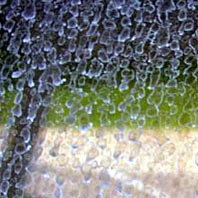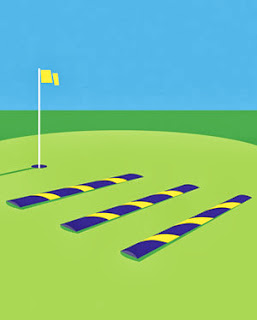It's hard to believe, but I'm feeling the need to write yet another blog post about our current bunker situation here at Quilchena. Why is this necessary you ask? First and foremost, I feel it is extremely important to continually communicate with the membership in order for them to better understand our concerns and challenges when it comes to maintaining their course. We are constantly trying to improve upon how we can best deliver optimum course conditions on a daily basis. Secondly, I still sense that there is not a clear understanding of exactly what our current bunker situation is. I spent some time searching back into my email archive and came across the following email that was sent to the Golf Committee back in early October of this year and I feel that it is important to share with you all. Please take the time to thoroughly read through it...
"Good morning all,
I urge you to please take the time to read this important
email about the condition of our bunkers.
After talking to many members this past weekend, it’s clear
that the majority are still not aware of exactly what bunker issues we are
dealing with. I’ve put together numerous info sheets documenting the
issues and have exhausted all of our communication resources (blog, eNews,
Herald, locker rooms, etc.) so I am asking you to please help me spread the
word. Many still believe the solution to our bunker problems is to simply
add new sand. Again, I cannot stress enough how much $$$ would be wasted
by going that route. Bunker sand is extremely expensive (more than double
the cost per ton of our greens topdressing sand) and although adding some new
sand might improve a few lies here and there, it is not the proper solution.
I once again dug out Larry Gilhuly’s report from his visit
back in June of 2008 (before my arrival to Quilchena) and it was clear back
then that the contamination issues in our bunkers were already a major
concern. Here is what Mr. Gilhuly had to say back then:
GREEN SURROUNDS
Observations and recommendations. The areas that
surround the greens (aprons, collars, bunkers and roughs) comprise the second
highest level of importance due to the proximity to the main target
and the need for many shots that require “touch”. While the
aprons have obviously improved with the addition of drainage and ongoing sand
topdressing (extremely important to continue), the bunkers and collars were
discussed with the following recommendations:
Contaminated
bunker sand – a demonstration and change is needed. This visit was
conducted following several days of dry weather, thus the bunkers appeared to
be well drained and firm. However, while observing several shots from various
bunkers (dust) and talking with those in attendance it is apparent that your sand is heavily contaminated with silt and
clay resulting in extremely firm conditions and poor drainage.
Please note the enclosed reprint that describes the life expectancy of various
components of a golf course. Bunker sand
generally can be expected to last from 7-10 years, however with good
hand maintenance and care golf courses have been viewed that last much longer
than this time frame. Bottom line –
Quilchena has far surpassed this time frame and is contaminated, thus your sand
should be considered for replacement. Once the realization of
sand replacement is accepted, the next series of questions includes:
o “Which sand should be used?”
o “Who should remove and add the
new sand?”
o “Will it be sand removal,
drainage and sand replacement or architectural change?”
Which
sand should be used? There are at least three good choices for sand in your
area including two sources from your local area (Baja and Bimini) and one from
Washington (Ravensdale) should you decide to stay with an off-white sand. There
are an equal amount of very bright white sources, yet the cost is generally
much higher and they will show any contamination much faster than the “tan”
sands. In nearly every case, the general recommendation is to simply take a
practice bunker, split it into three or four parts and test each of the sands
in a side-by-side comparison for at least one year. Quilchena does not have
this option due to the lack of a good practice bunker, thus it was suggested to
test these sands on the golf course in three separate bunkers near the
clubhouse, such as No. 18. Each bunker would have the sand described earlier
installed with either the Baja bunker or Ravensdale bunker having half of the
bunker with a combination of these two sands. This is due to the high cost of
the Ravensdale sand and the many golf courses in your area that have added Baja
sand into the Ravensdale material with good results. Regardless, make sure to
add ample drainage and also consider three different techniques to keep the sand
clean. After drainage is installed, line one bunker with Sand Trapper II,
another with perennial ryegrass sod and a third using the technique from Marine
Drive where Portland cement has been used with success for earthworms. Test all
of the sands and liners for at least one year to determine which is best and
then consider a sand replacement program after Nos. 1-5 have been improved.
Who
should remove and add the new sand? While it may be tempting to assume that
this is a job that can be completed by your maintenance staff, this method of
addressing this issue was not recommended. The
amount of time required to complete this type of operation would require at
least 3-4 additional employees as it will not be a simple sand removal and
replacement project. Drainage must be added with the type shown in
the upper right photo the type of extensive drainage recommended to assure
complete and rapid water removal. Should you decide to complete this in-house,
Portland Golf Club faced the exact same situation when they were installing
their sand/slit drainage last year. They also had the same sand found at
Quilchena and decided to simply extend the sand/slit drainage from the fairways
and roughs near the bunkers under the bunkers when the sand was removed. The
results have been exceptional thus far, thus this same type of drainage
connection could be completed at Quilchena, however it would best be completed
by an outside contractor with experience to complete the bunkers in a much
faster manner.
· Will
it be sand removal, drainage and sand replacement or architectural change?
This answer can only come from your membership as architectural changes will
greatly increase the cost of this project. There
is no question that the sand needs to be removed and drainage needs to be
added. Also, some type of liner is needed to ensure your sand
remains clean for as long as possible. The need for architectural change should
only be contemplated as part of your master plan with a qualified golf course
architect."
As always, please feel free to contact me with any questions you may have.
604-277-1513










